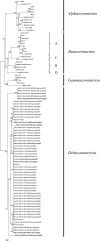Discovery of seven novel Mammalian and avian coronaviruses in the genus deltacoronavirus supports bat coronaviruses as the gene source of alphacoronavirus and betacoronavirus and avian coronaviruses as the gene source of gammacoronavirus and deltacoronavirus
- PMID: 22278237
- PMCID: PMC3302495
- DOI: 10.1128/JVI.06540-11
Discovery of seven novel Mammalian and avian coronaviruses in the genus deltacoronavirus supports bat coronaviruses as the gene source of alphacoronavirus and betacoronavirus and avian coronaviruses as the gene source of gammacoronavirus and deltacoronavirus
Abstract
Recently, we reported the discovery of three novel coronaviruses, bulbul coronavirus HKU11, thrush coronavirus HKU12, and munia coronavirus HKU13, which were identified as representatives of a novel genus, Deltacoronavirus, in the subfamily Coronavirinae. In this territory-wide molecular epidemiology study involving 3,137 mammals and 3,298 birds, we discovered seven additional novel deltacoronaviruses in pigs and birds, which we named porcine coronavirus HKU15, white-eye coronavirus HKU16, sparrow coronavirus HKU17, magpie robin coronavirus HKU18, night heron coronavirus HKU19, wigeon coronavirus HKU20, and common moorhen coronavirus HKU21. Complete genome sequencing and comparative genome analysis showed that the avian and mammalian deltacoronaviruses have similar genome characteristics and structures. They all have relatively small genomes (25.421 to 26.674 kb), the smallest among all coronaviruses. They all have a single papain-like protease domain in the nsp3 gene; an accessory gene, NS6 open reading frame (ORF), located between the M and N genes; and a variable number of accessory genes (up to four) downstream of the N gene. Moreover, they all have the same putative transcription regulatory sequence of ACACCA. Molecular clock analysis showed that the most recent common ancestor of all coronaviruses was estimated at approximately 8100 BC, and those of Alphacoronavirus, Betacoronavirus, Gammacoronavirus, and Deltacoronavirus were at approximately 2400 BC, 3300 BC, 2800 BC, and 3000 BC, respectively. From our studies, it appears that bats and birds, the warm blooded flying vertebrates, are ideal hosts for the coronavirus gene source, bats for Alphacoronavirus and Betacoronavirus and birds for Gammacoronavirus and Deltacoronavirus, to fuel coronavirus evolution and dissemination.
Figures








Similar articles
-
Discovery and Sequence Analysis of Four Deltacoronaviruses from Birds in the Middle East Reveal Interspecies Jumping with Recombination as a Potential Mechanism for Avian-to-Avian and Avian-to-Mammalian Transmission.J Virol. 2018 Jul 17;92(15):e00265-18. doi: 10.1128/JVI.00265-18. Print 2018 Aug 1. J Virol. 2018. PMID: 29769348 Free PMC article.
-
Comparative analysis of complete genome sequences of three avian coronaviruses reveals a novel group 3c coronavirus.J Virol. 2009 Jan;83(2):908-17. doi: 10.1128/JVI.01977-08. Epub 2008 Oct 29. J Virol. 2009. PMID: 18971277 Free PMC article.
-
Epidemiology and evolution of novel deltacoronaviruses in birds in central China.Transbound Emerg Dis. 2022 Mar;69(2):632-644. doi: 10.1111/tbed.14029. Epub 2021 May 5. Transbound Emerg Dis. 2022. PMID: 33559368 Free PMC article.
-
Coronavirus diversity, phylogeny and interspecies jumping.Exp Biol Med (Maywood). 2009 Oct;234(10):1117-27. doi: 10.3181/0903-MR-94. Epub 2009 Jun 22. Exp Biol Med (Maywood). 2009. PMID: 19546349 Review.
-
Bat origin of human coronaviruses.Virol J. 2015 Dec 22;12:221. doi: 10.1186/s12985-015-0422-1. Virol J. 2015. PMID: 26689940 Free PMC article. Review.
Cited by
-
Activation of STING Signaling Pathway Effectively Blocks Human Coronavirus Infection.J Virol. 2021 May 24;95(12):e00490-21. doi: 10.1128/JVI.00490-21. Print 2021 May 24. J Virol. 2021. PMID: 33789998 Free PMC article.
-
Detection and Genetic Diversity of Porcine Coronavirus Involved in Diarrhea Outbreaks in Spain.Front Vet Sci. 2021 Feb 25;8:651999. doi: 10.3389/fvets.2021.651999. eCollection 2021. Front Vet Sci. 2021. PMID: 33718476 Free PMC article.
-
Highly pathogenic coronaviruses: thrusting vaccine development in the spotlight.Acta Pharm Sin B. 2020 Jul;10(7):1175-1191. doi: 10.1016/j.apsb.2020.05.009. Epub 2020 May 30. Acta Pharm Sin B. 2020. PMID: 32834948 Free PMC article. Review.
-
Myotis fimbriatus Virome, a Window to Virus Diversity and Evolution in the Genus Myotis.Viruses. 2022 Aug 27;14(9):1899. doi: 10.3390/v14091899. Viruses. 2022. PMID: 36146706 Free PMC article.
-
Attenuation of porcine deltacoronavirus disease severity by porcine reproductive and respiratory syndrome virus coinfection in a weaning pig model.Virulence. 2021 Dec;12(1):1011-1021. doi: 10.1080/21505594.2021.1908742. Virulence. 2021. PMID: 33797313 Free PMC article.
References
Publication types
MeSH terms
Substances
Associated data
- Actions
- Actions
- Actions
- Actions
- Actions
- Actions
- Actions
- Actions
LinkOut - more resources
Full Text Sources
Other Literature Sources

